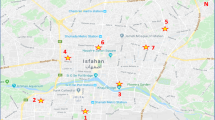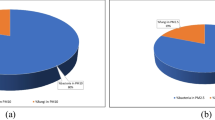Abstract
The land-use configuration has huge impact on emission sources and also a major influencing factor, which ultimately determine the microbial count, composition and seasonal dynamics of bioaerosols at respective site. Despite this, very few studies compare bioaerosols exposure at different land-use sites. The aim of the present study was to measure and compare the aerosolised bacterial and fungal counts across seasons using active Anderson cascade impactor at different land-use configurations in an urban metropolitan. The counts of aerosolised bacteria and fungi were estimated across five seasons of a tropical climate. A mixed-effect model showed that the season and land-use configuration have a bearing on microbial counts. Season and land use interact in a complex manner to produce bioaerosol count variability. Meteorological parameter (temperature and relative humidity) had a significant effect on microbial counts at all land-use configurations, but they could not fully explain variations of microbial counts in the mixed model.

Similar content being viewed by others
References
Adams, R. I., Bhangar, S., Pasut, W., Arens, E. A., Taylor, J. W., Lindow, S. E., et al. (2015). Chamber bioaerosol study: outdoor air and human occupants as sources of indoor airborne microbes. PLoS ONE,10(5), e0128022. https://doi.org/10.1371/journal.pone.0128022.
Arnfield, A. J. (2003). Two decades of urban climate research: a review of turbulence, exchanges of energy and water, and the urban heat island. International Journal of Climatology,23(1), 1–26.
Balyan, P., Ghosh, C., Das, S., & Banerjee, B. D. (2017). Spatial variation of biogenic aerosols at different land use configurations in urban Delhi. International Journal of Applied Environmental Sciences,12(5), 731–744.
Bičík, I., Kupková, L., Jeleček, L., Kabrda, J., Štych, P., Janoušek, Z., et al. (2015). Land use changes in the Czech Republic 1845–2010: socio-economic driving forces. Berlin: Springer.
Bowers, R. M., McLetchie, S., Knight, R., & Fierer, N. (2011). Spatial variability in airborne bacterial communities across land-use types and their relationship to the bacterial communities of potential source environments. The ISME journal,5(4), 601–612.
Burge, P. S. (2004). Sick building syndrome. Occupational and Environmental Medicine,61(2), 185–190.
De Rensis, F., & Scaramuzzi, R. J. (2003). Heat stress and seasonal effects on reproduction in the dairy cow—a review. Theriogenology,60(6), 1139–1151.
Fernando, W. G., Miller, J. D., Seaman, W. L., Seifert, K., & Paulitz, T. C. (2000). Daily and seasonal dynamics of airborne spores of Fusarium graminearum and other Fusarium species sampled over wheat plots. Canadian Journal of Botany,78(4), 497–505.
Garson, G. D. (2012). Testing statistical assumptions. Asheboro: Statistical Associates Publishing.
Heo, K. J., Lim, C. E., Kim, H. B., & Lee, B. U. (2017). Effects of human activities on concentrations of culturable bioaerosols in indoor air environments. Journal of Aerosol Science,104, 58–65.
Horanont, T., Phithakkitnukoon, S., Leong, T. W., Sekimoto, Y., & Shibasaki, R. (2013). Weather effects on the patterns of people’s everyday activities: a study using GPS traces of mobile phone users. PLoS ONE,8(12), e81153. https://doi.org/10.1371/journal.pone.0081153.
Kempka, D., & Browne, D. (2005). Terrestrial Carbon Offsets for Industry Portfolios. In P. C. Fusaro & M. Yuen (Eds.), Green Trading Markets (pp. 159–177). New York: Elsevier Science. https://doi.org/10.1016/B978-008044695-0/50001-X.
Meredith, D. S. (1973). Significance of spore release and dispersal mechanisms in plant disease epidemiology. Annual Review of Phytopathology, 11(1), 313–342.
Nasir, Z. A., Colbeck, I., Sultan, S., & Ahmed, S. (2012). Bioaerosols in residential micro-environments in low income countries: a case study from Pakistan. Environmental Pollution,168, 15–22.
Womack, A. M., Artaxo, P. E., Ishida, F. Y., Mueller, R. C., Saleska, S. R., Wiedemann, K. T., et al. (2015). Characterization of active and total fungal communities in the atmosphere over the Amazon rainforest. Biogeosciences,12(21), 6337–6349.
Zimbro, D. A. P. M. J. (2003). Difco & BBL manual: Manual of microbiological culture media. Maryland: Becton, Dickinson and Company.
Author information
Authors and Affiliations
Corresponding author
Rights and permissions
About this article
Cite this article
Balyan, P., Ghosh, C., Das, S. et al. Spatio-temporal characterisation of bioaerosols at diverse outdoor land-use sites in an urban environment. Aerobiologia 36, 77–81 (2020). https://doi.org/10.1007/s10453-019-09582-2
Received:
Accepted:
Published:
Issue Date:
DOI: https://doi.org/10.1007/s10453-019-09582-2




